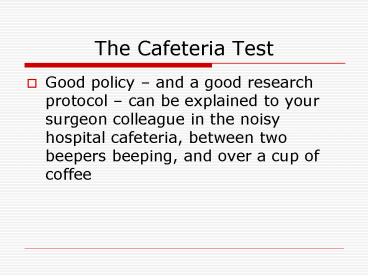The Cafeteria Test - PowerPoint PPT Presentation
Title:
The Cafeteria Test
Description:
The Cafeteria Test Good policy and a good research protocol can be explained to your surgeon colleague in the noisy hospital cafeteria, between two beepers ... – PowerPoint PPT presentation
Number of Views:91
Avg rating:3.0/5.0
Title: The Cafeteria Test
1
The Cafeteria Test
- Good policy and a good research protocol can
be explained to your surgeon colleague in the
noisy hospital cafeteria, between two beepers
beeping, and over a cup of coffee
2
Pregnancy Fetotoxicity- NeonatologyWhere Myths
Persist
- For instance Efavirenz is teratogenic
3
Efavirenz and pregnancy
- Teratogenicity/Developmental Toxicity Animal
StudiesMalformations were observed in three of
20 infants born to pregnant cynomolgus monkeys
receiving efavirenz from gestational days 20 to
150 at a dose of 30 mg/kg twice daily (resulting
in plasma concentrations comparable to systemic
human therapeutic exposure). The malformations
included anencephaly and unilateral anophthalmia
in one microphthalmia in another and cleft
palate in the third. Primate teratogenicity
studies have not been conducted for delavirdine
or nevirapine.
4
Antiretroviral Pregnancy Register
- Overall, the prevalence of birth defects in 2427
live births was 3.0 percent. The CI of 2.4-3.8
includes the prevalence in patients not exposed
to ARVs (2.7) indicating no significant
difference - For abc, lpv, efv, nvp, tfv, rtv, sufficient
births have accrued to exclude a two-fold
increase, and for 3-TC and zdv, a 1.5-fold
increase can be excluded - Regarding efv 7 defects in 281 first trimester
exposures, i.e. 2.5 (confidence interval 1.0
5.1), none of which resembled the CNS lesions in
monkeys - 3 cases of myelomeningocoele reported in the
literature
www.apregistry.com, accessed December 15, 2007.
Last interim report June 2007
5
Ciprofloxacin is contra-indicated
- Bone problems in puppies, not reproduced in other
species - In dogs, some quinolones do, others dont. The
most powerful of all nalidixic acid, a precursor
drug used widely in the 1970ies - Follow-up of these children, now adults No bone
problems. - Inadvertent exposure Nothing
- Inspite of this, the pediatric c.-i. to cipro
still exists
6
Spurious contra-indications
- A luxury for the rich
- A burden for the poor
7
SMART (Strategies for Manage-ment of
anti-retroviral therapies)
Patients with gt 350 CD4 cells, mostly on
treatment, willing to be randomized to
- Drug conservation (DC or STI) arm Treatment
stopped if CD4 gt 350, started at lt 250 - Virologic suppression (VS or CT) arm Keep VL lt
50 at all times
8
SMART As Planned
- NIH, CPCRA
- 6000 patients, planned follow-up of 5 to 9 years
- 900 endpoints expected in 2009, with power to
detect difference of approximately 20 between
arms
9
SMART As It Turned out
- Recruitment suspended on January 11, 2006, after
5472 patients had been recruited, and 164
endpoints observed - Excess of endpoints in the STI (DC) arm
10
Primary endpoint of OI/death
STI group CT group
Curves diverge after 4 months
11
SMART Confirmed Events
- Event STI CT RR P
- N /100py N /100 py
- AIDS/death 118 3.3 46 1.3 2.63 lt10-4
- Death 55 1.5 30 0.8 1.84 0.007
12
SMART Type of AIDS Events
- Event STI CT
- Esophageal candidiasis 24 7
- PCP 8 2
- Recurrent bacterial pneumonia 7 2
- Kaposis 6 1
- Persistent herpes simplex 3 2
- Lymphoma 4 1
- Disseminated zoster 3 1
- TB 2 2
- All others 7 2
- Patients with any event 54 17
13
Few Deaths are AIDS-Related
- Type STI CT
- Cancer (excluding AIDS-related) 11 5
- Cardiovascular 7 4
- Substance abuse 3 5
- Accident, suicide, violence 3 4
- AIDS-related opp. disease 4 3
- Other infections 3 1
- Various other causes 9 5
- Unknown 15 3
- Total 55 30
14
SMART (Supposedly) Drug-Related AEs Are Also
Worse in STI Group
- Event STI CT RR P
- N /100py N /100 py
- MI, major CAD,stroke, RF, LF 63 1.8 38 1.0 1.68
0.01
15
What if Treatment Was Re-started at Higher CD4
Counts ?
- STI CT RR Delta NNP
- Last CD4lt 250 7.6 10.5 0.72 250-349 4.2 2.3 1.83
1.9 32 350-499 2.7 1.4 1.93 1.3 47gt499 2.0 1.2
1.67 0.8 76 - Number of patients with endpoints (AIDS or
death) per 100 patient-years of follow-up. - NNP number of patient years of treatment
needed to prevent 1 event, considering that
patients in the STI group were treated during 33
percent of days, compared to 94 percent in the CT
group
16
The Cost-Effectiveness of HAART
- Numbers from Switzerland
- Before HAART, approx. 800 AIDS/Deaths per year
- After HAART, approximately 100
- Approximately 5000 patients are being treated
- 5000/700 or approximately 7 years worth of
treatment to prevent one event
17
I would like to stop. Can I do so safely?
18
- STI CT RR Delta NNP
- Last CD4lt 250 7.6 10.5 0.72 250-349 4.2 2.3 1.83
1.9 32 350-499 2.7 1.4 1.93 1.3 47gt499 2.0 1.2
1.67 0.8 76
The Future of STIs (1) At higher CD4 counts
500 to stop, 400 to start again
19
Summary Harmful to Stop ?
- SMART participants started HAART at CD4 counts of
approx. 200 (median, large range) - Intermittent treatment is inferior to continuous
treatment - Holds true at all CD4 counts
- At high CD4 counts, NNP exceeds 50 years of
treatment to prevent one event
SMART does not show that intermittent treatment
is inferior to no treatment
20
When To Stop ?(in women who started ART for PMCT)
- Women who had an indication for treatment (CD4 lt
350) SMART says Dont stop ! - Women who did not have an indication Treat for
one year, then stop. - If treatment started without CD4 count measured
Stop after 1 year. Measure CD4 counts after
three months, treat if lt 350.
























![ALL-TOGETHER-[total, sum] APARTMENT BOOKSTORE CAFETERIA-[restaurant, bachelor] DIVIDE PowerPoint PPT Presentation](https://s3.amazonaws.com/images.powershow.com/P1254156718cDFsW.th0.jpg?_=20140825084)






